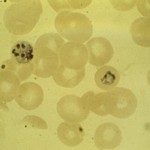Link to Pubmed [PMID] – 38017455
Link to DOI – 10.1186/s12936-023-04796-9
Malar J 2023 Nov; 22(1): 363
Dual hrp2/hrp3 genes deletions in P. falciparum isolates are increasingly reported in malaria-endemic countries and can produce false negative RDT results leading to inadequate case management. Data on the frequency of hrp2/hrp3 deleted parasites are rarely available and it has become necessary to investigate the issue in Burkina Faso.Plasmodium falciparum-positive dried blood spots were collected during a cross-sectional household survey of the malaria asymptomatic children from Orodara, Gaoua, and Banfora. Amplicons from the target regions (exon 2 of hrp2 and hrp3 genes) were generated using multiplexed nested PCR and sequenced according to Illumina’s MiSeq protocol.A total of 251 microscopically positive parasite isolates were sequenced to detect hrp2 and hrp3 gene deletions. The proportion of RDTs negative cases among microscopy positive slides was 12.7% (32/251). The highest prevalence of negative RDTs was found in Orodara 14.3% (5/35), followed by Gaoua 13.1%(24/183), and Banfora 9.1% (3/33). The study found that 95.6% of the parasite isolates were wild type hrp2/ hrp3 while 4.4% (11/251) had a single hrp2 deletion. Of the 11 hrp2 deletion samples, 2 samples were RDT negative (mean parasitaemia was 83 parasites/ μL) while 9 samples were RDT positive with a mean parasitaemia of 520 parasites /μL (CI95%: 192-1239). The highest frequency of hrp2 deletion 4/35 (11.4%) was found in Orodara, while it was similar in the other two sites (< 3.5%). No single deletion of the hrp3 or dual deletion hrp2/3 gene was detected in this study.These results demonstrate that P. falciparum isolates lacking hrp2 genes are present in 4.4% of samples obtained from the asymptomatic children population in three sites in Burkina Faso. These parasites are circulating and causing malaria, but they are also still detectable by HRP2-based RTDs due to the presence of the intact pfhrp3 gene.

